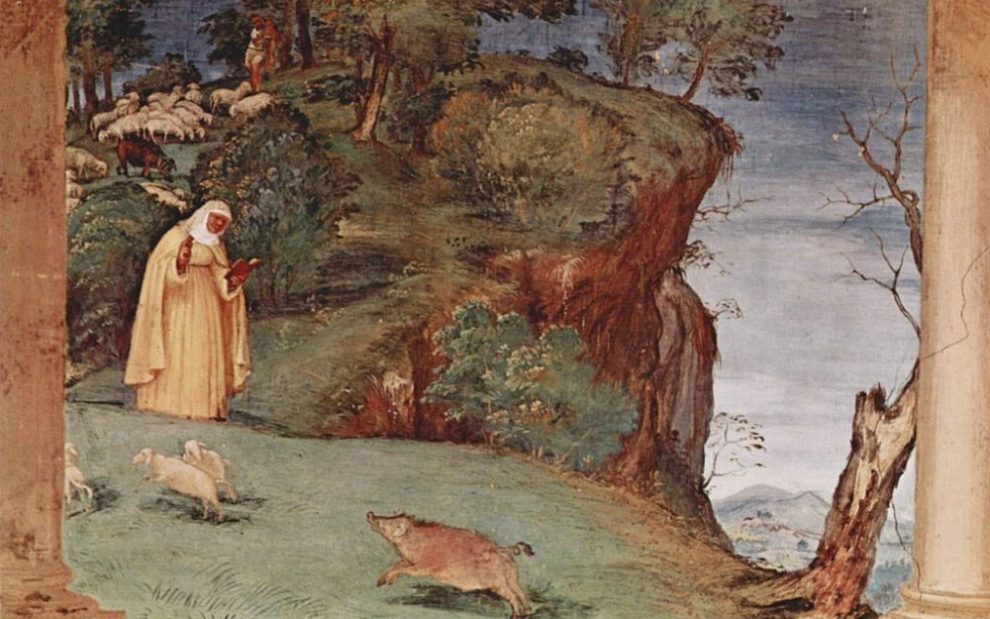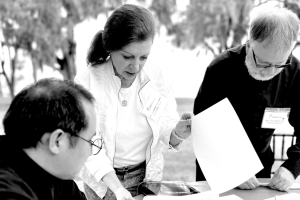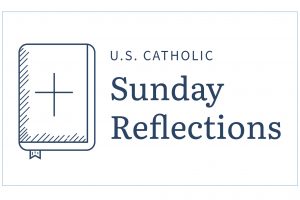A millennium and a half before Jorge Bergoglio became pope, a baby girl was born on the margins: Neither here nor there, neither slave nor free, neither Christian nor pagan, she entered the world quite literally on the threshold, half in and half out of her father’s house, according to the Vita Prima, one of the earliest accounts of her life.
Her mother, an enslaved Christian, wrapped her up in lamb’s wool, baptized her in milk, and named her Brigid, which means “fiery arrow.” And for the rest of her life, a blaze of fire followed her and lit up the life of every single person she met.
This was Brigid of Kildare, the great saint of Ireland, who spread the gospel, worked mighty miracles, and spent her life caring for the poor and the sick.
I’ve been thinking about her a lot since Pope Francis died on Easter Monday. He was a good man, a holy man—as the Irish say, the likes of him will never be seen again. He devoted his life to the poor and forgotten, the hungry and lost. How connected was Francis to St. Brigid of Kildare? I like to think they were, at least a little. Surely they were kindred spirits.
When it came to tender care and respect for the poor and the lost, Francis had no equal. But that same deep respect didn’t seem to extend to the women of the church. As much as we loved him, he left me and other Catholic women disappointed and frustrated. There was his abrupt “no” to journalist Nora O’Donnell, who asked him if women will ever be priests; there were constant studies and commissions that put off the urgent cries of women around the world who were longing to serve the church they loved.
He appointed brilliant nuns to important positions at the Vatican; he listened thoughtfully to women theologians—he was a Jesuit, after all. But there was no room for them at the altar.
“The Church is woman,” Francis said in 2024. “She is the bride of Jesus. To masculinize women is not human. Women, I aways say, are more important than men, because the Church is the bride of Jesus.”
Well, maybe. Who knows? But Francis seemed to miss the point. Women aren’t looking to be more important than men, or looking to be masculinized. We’re not looking for a pedestal, either.
What we long for is simple: our baptismal equality. “For all of you who were baptized into Christ have clothed yourselves with Christ,” writes Paul in his letter to the Galatians. “There is neither Jew nor Greek, there is neither slave nor free person, there is neither male nor female; for you are all one in Christ Jesus.” (Gal. 3: 28)
Fifteen hundred years ago, Brigid of Kildare understood. The Ireland where she lived was no feminist paradise, but in her book Women in a Celtic Church: Ireland 450-1150 (Oxford University Press), Christina Harrington argues it granted women a place in society—as druids and poets before Christianity arrived, as nuns and abbesses and even bishops afterward.
Brigid was nobody’s fool. Her life was lived to serve God, and she let nothing get in her way. An early Life of Brigid, written in Irish and Latin, says that when her father tried to marry her off, she plucked out her eye to stop the wedding. Endless folk stories recount that when she wanted more land for her monastery, she tricked the king into giving her as much as she needed.
When she was ready to take the veil, says the ninth-century writer who composed the Irish Life of Brigid, the bishop conferred holy orders on her instead. And if there was any question about the ordination, all you had to do was look at the tongues of flame shooting from her head. The message was clear: The apostles, the first bishops of the church, were anointed with the flaming tongues of the Holy Spirit on Pentecost. Brigid, the fiery saint of Kildare, was clearly anointed a bishop too.
Not only did she embrace her episcopal orders—her hagiographies clearly show her living them out. She was the leader of her faith community, performing liturgical functions— hearing confessions, granting absolution, preaching. The Lives of the Saints, from the 15-century Book of Lismore, suggests that she celebrated the Eucharist too. For hundreds of years, the Irish Annals show her episcopal authority being passed on to her successor abbesses at her monastery in Kildare.
Her fellow bishops seemed to be OK with that. They were frequent visitors at Kildare, where they sought Brigid’s counsel and enjoyed her hospitality. Not enough butter for the bishops’ dinner? In Brigid’s dairy, writes the monk Cogitosus in his account of the saint’s life, butter was multiplied like, well, like loaves and fishes. No beer? No problem. In a pinch, Brigid could turn a tub of bathwater or an entire lake into “beer with the fragrance of wine,” according to Celtic Spirituality (Paulist Press), edited and translated by Oliver Davies.
Obviously, the bishops were happy to be in her company. And when they had problems, it was Brigid they called on—the medieval Lives of Brigid have stories galore about Brigid’s wisdom and efficiency. They invited her to their synods, where matters small and large were on the docket: Who is the father of this fatherless child? Who was the thief who stole a woman’s silver brooch? And what was to be done about the bickering construction crews and the road that just wasn’t getting built? Though the bishops were flummoxed, it was Brigid who figured it all out.
She was even invited to a synod with Patrick himself. “We have been told that Patrick is coming from the south of Ireland,” said Bishop Mel, who had ordained Brigid. “We will go and speak to him. Will you go too?” Of course she would, according to Celtic Spirituality: “I will,” she replied, “so that I may see him and speak to him and so that he may give me his blessing.” That’s the kind of easy familiarity and friendship Brigid enjoyed with the leaders of the Irish church. She was, it seemed, one of them.
In the early Irish church, there were constant decisions that had to be made, from the date of Easter to the Order of the Mass. Brigid was an important part of the synods of church leaders that made those decisions. Today, as Francis enters his eternal reward, an enormous decision is waiting to be made: Who will lead the church in a post-Francis world? When the conclave opens later this week week, a few hundred men from around the globe will descend upon Rome to give their two-cents’ worth and cast their ballots. Apart from the nuns cooking and serving the meals (we’ve all seen the film Conclave), everyone there will be male.
But there’s nothing in scripture that excludes women from the process—or even the position, for that matter. In choosing a new pope, what would we gain from adding the voices of women to those male voices in the Sistine Chapel? What will we lose without them? “We will miss Pope Francis,” says Sr. Rita Minehan, director of the Solas Bhride Center in Kildare, Ireland, just down the road from the site of Brigid’s monastery. “He has left the door ajar and hopefully it will widen further during the next papacy.”
That’s our wish, and our prayer. In times of change and uncertainty like this, as the conclave is about to begin, we can ask: What would Brigid do?
Image: Wikimedia Commons/Lorenzo Lotto, A Blessing by Brigid of Kildare












Add comment